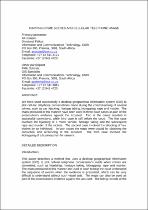JavaScript is disabled for your browser. Some features of this site may not work without it.
- ResearchSpace
- →
- Research Publications/Outputs
- →
- Conference Publications
- →
- View Item
| dc.contributor.author |
Schmitz, P

|
|
| dc.contributor.author |
Cooper, Antony K

|
|
| dc.date.accessioned | 2009-01-09T10:05:57Z | |
| dc.date.available | 2009-01-09T10:05:57Z | |
| dc.date.issued | 2000-12 | |
| dc.identifier.citation | Schmitz, PMU and Cooper, AK. Mapping crime scenes and cellular telephone usage. Crime Mapping Research; 4th Annual International Conference, San Diego, California, USA, December 9-12, 2000, pp 6 | en |
| dc.identifier.uri | http://hdl.handle.net/10204/2788 | |
| dc.description.abstract | This paper describes a method that uses a desktop geographical information system (GIS) to plot cellular telephone conversations made when crimes are committed, such as hijackings, hostage taking, kidnapping, rape and murder. The maps produced in this manner are used in court to help the court understand the sequence of events when the evidence is presented, which can be very difficult to understand without such visual aids. The maps can also be used as part of the prosecution's evidence against the accused. The billing records of the relevant telephones are obtained through a search warrant and for each call made before, during and after the commissioning of crimes, the approximate locations of the two telephones are plotted on a map. | en |
| dc.language.iso | en | en |
| dc.subject | Desktop geographical information systems | en |
| dc.subject | GIS | en |
| dc.subject | Geographical Information Systems | en |
| dc.subject | Cellular telephone conversations | en |
| dc.title | Mapping crime scenes and cellular telephone usage | en |
| dc.type | Conference Presentation | en |
| dc.identifier.apacitation | Schmitz, P., & Cooper, A. K. (2000). Mapping crime scenes and cellular telephone usage. http://hdl.handle.net/10204/2788 | en_ZA |
| dc.identifier.chicagocitation | Schmitz, P, and Antony K Cooper. "Mapping crime scenes and cellular telephone usage." (2000): http://hdl.handle.net/10204/2788 | en_ZA |
| dc.identifier.vancouvercitation | Schmitz P, Cooper AK, Mapping crime scenes and cellular telephone usage; 2000. http://hdl.handle.net/10204/2788 . | en_ZA |
| dc.identifier.ris | TY - Conference Presentation AU - Schmitz, P AU - Cooper, Antony K AB - This paper describes a method that uses a desktop geographical information system (GIS) to plot cellular telephone conversations made when crimes are committed, such as hijackings, hostage taking, kidnapping, rape and murder. The maps produced in this manner are used in court to help the court understand the sequence of events when the evidence is presented, which can be very difficult to understand without such visual aids. The maps can also be used as part of the prosecution's evidence against the accused. The billing records of the relevant telephones are obtained through a search warrant and for each call made before, during and after the commissioning of crimes, the approximate locations of the two telephones are plotted on a map. DA - 2000-12 DB - ResearchSpace DP - CSIR KW - Desktop geographical information systems KW - GIS KW - Geographical Information Systems KW - Cellular telephone conversations LK - https://researchspace.csir.co.za PY - 2000 T1 - Mapping crime scenes and cellular telephone usage TI - Mapping crime scenes and cellular telephone usage UR - http://hdl.handle.net/10204/2788 ER - | en_ZA |






